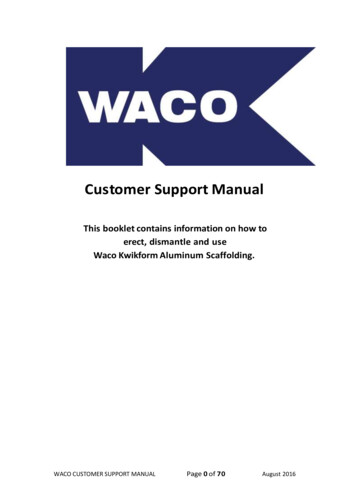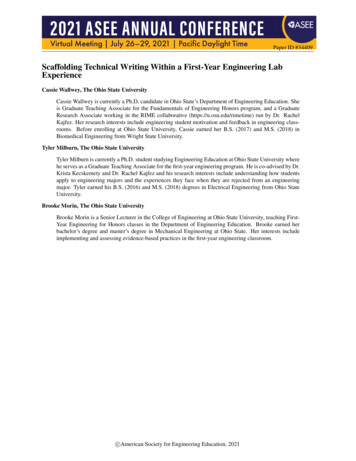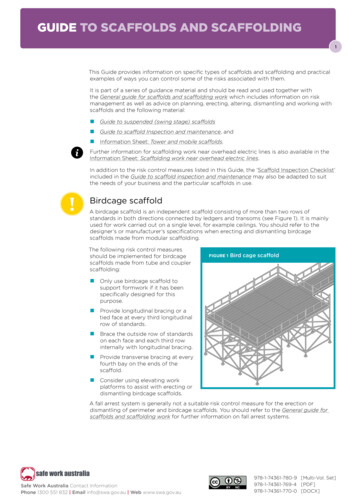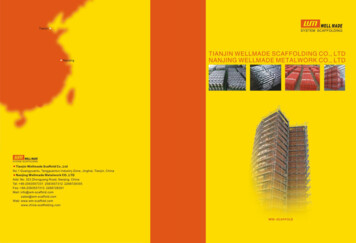
Transcription
ScaffoldingCode of Practice2021Scaffolding Code of Practice 2021Page 1 of 77
This Queensland code of practice has been approved by the Minister for Education andIndustrial Relations under section 274 of the Work Health and Safety Act 2011.This code commenced on 1 July 2021 with the exception of section 2.7.1.1 of the code whichhas a delayed commencement. Section 2.7.1.1 sets out that where there is a change indirection between landings, any difference in step height from the scaffold stair to an access oregress point should be minimised so that it is no more than 300mm. Section 2.7.1.1 applies tostand-alone scaffolding where erection commences 12 months after 1 July 2021.PN12684ISBN Creative CommonsThis copyright work is licensed under a Creative Commons Attribution-Noncommercial 4.0 Internationallicence. To view a copy of this licence, visit creativecommons.org/licenses. In essence, you are free to copy,communicate and adapt the work for non-commercial purposes, as long as you attribute the work to Safe WorkAustralia and abide by the other licence terms.Scaffolding Code of Practice 2021Page 2 of 77
ContentsForeword . 6Scope and application . 61. Introduction . 71.1 What is scaffolding?. 71.2 What is construction work? . 71.3 Who has health and safety duties in relation to scaffolding work? . 71.4 What is involved in managing risks associated with scaffolding work? . 81.4.1 Consulting workers . 91.4.2 Consulting, cooperating and coordinating activities with other dutyholders . 91.5 Information, training, instruction and supervision . 101.5.1 High risk work licences . 111.5.2 Competency . 112. Planning and design . 122.1 Planning construction activities . 122.1.1 WHS management plans . 122.1.2 Safe work method statements . 122.1.3 Scaffold plans. 132.2 Design . 132.3 Foundations . 162.3.1 Ground conditions . 162.3.2 Loadings. 162.3.3 Soleboards and baseplates . 192.4 Stability . 202.4.1 Tying . 202.5 Perimeter containment screening . 212.6 Working platforms . 222.7 The work environment . 242.7.1 Access and egress . 242.7.2 Lighting . 262.7.3 Maintaining a safe work environment . 263. Hazards . 273.1 Working near energised overhead electric lines . 273.2 Mobile plant and traffic . 293.3 Fixed plant . 293.4 Mixing scaffold components . 293.5 Falls from height . 303.5.1 Risk of a fall at any height . 303.5.2 Risk of a fall when erecting scaffold . 313.5.3 Risk of a fall when dismantling scaffold . 313.5.4 Fall arresting platforms . 313.5.5 Edge protection . 323.5.6 Fall-arrest systems . 323.6 Falling objects . 333.6.1 Preventing objects from falling . 343.6.2 Gaps . 343.7 Scaffold collapse. 35Scaffolding Code of Practice 2021Page 3 of 77
3.8 Unauthorised access, use or alteration . 353.9 Scaffold quality . 353.10 Ground conditions . 363.11 Hazardous manual tasks . 363.11.1 Examples of design controls . 363.11.2 Examples of administrative controls . 373.12 Fire and explosion . 374. Erecting, altering or dismantling scaffold . 384.1 Safe erection of scaffold . 384.2 Scaffold alteration . 394.3 Safe dismantling of scaffold . 395. Types of scaffold . 405.1 Independent scaffold . 405.1.1 Birdcage scaffold . 405.1.2 Tower scaffold . 415.1.3 Mobile scaffold . 415.1.4 Hung scaffold . 425.2 Single pole scaffold . 435.3 Suspended (swing-stage) scaffold . 435.3.1 Design issues . 445.3.2 Counterweight calculation . 445.3.3 Method of fixing needles . 445.3.4 Suspension systems . 455.3.5 Scaffold hoists . 455.3.6 Cradles . 455.3.7 Trolleys. 465.3.8 Fall-arrest and travel restraint harness systems. 465.4 Complex scaffolds . 465.4.1 Cantilever scaffold . 465.4.2 Hanging bracket scaffold . 475.4.3 Spur scaffold . 475.5 Scaffolding for demolition work . 476. Inspection and maintenance procedures . 496.1 Frequency of inspection of scaffold . 496.2 Structural inspection of scaffolding components . 496.3 Hand over inspections . 50Appendix 1: Dictionary . 51Appendix 2: Inspection checklist. 55Appendix 3: Published technical standards . 57Appendix 4: Scaffold handover certificate – scaffold over four metres . 58Appendix 5: Compliance pack for suspended (swing-stage) scaffolds . 59Swing-stage advice. 61A5.1 Equipment supply advice . 61A5.2 Scaffold environment advice . 62A5.3 Installation design advice . 62A5.4 Scaffold erection advice . 63A5.5 Electrical installation advice . 64A5.6 Scaffold operation advice. 65A5.7 Boatswain’s chair operation advice. 66PCBU checklists . 67Scaffolding Code of Practice 2021Page 4 of 77
A5.8 Swing-stage scaffold supplier checklist . 67A5.9 Swing-stage scaffold principal contractor / body corporate checklist . 67A5.10 Swing-stage scaffold erection and installation checklist . 68A5.11 Swing-stage scaffold electrical installation checklist . 68A5.12 Swing-stage scaffold handover checklist . 69A5.13 Swing-stage scaffold and boatswain’s chair operation checklist . 69A5.14 Unattended swing-stage scaffold checklist . 70A5.15 Inspection, servicing and maintenance checklist . 70Verification forms . 71Principal contractor or building owner swing-stage statement . 72Competent person benchmarks for swing-stage set-up verification . 73Swing-stage suspension system verification statement . 75Scaffolding Code of Practice 2021Page 5 of 77
ForewordThis Scaffolding Code of Practice is an approved code of practice under section 274 of theWork Health and Safety Act 2011 (the WHS Act).An approved code of practice is a practical guide to achieving the standards of health,safety and welfare required under the WHS Act and the Work Health and Safety Regulation2011 (the WHS Regulation).Under section 26A of the WHS Act duty holders must comply with an approved codeof practice or follow another method, such as a technical or industry standard, if itprovides an equivalent or higher standard of work health and safety than thestandard required in this code.A code of practice applies to anyone who has a duty of care in the circumstances describedin the code. In most cases, following an approved code of practice would achievecompliance with the health and safety duties in the WHS Act, in relation to the subjectmatter of the code. Like regulations, codes of practice deal with particular issues and do notcover all hazards or risks which may arise. The health and safety duties require dutyholders to consider all risks associated with work, not only those for which regulations andcodes of practice exist.Codes of practice are admissible in court proceedings under the WHS Act and WHSRegulation. Courts may regard a code of practice as evidence of what is known about ahazard, risk or control and may rely on the code in determining what is reasonablypracticable in the circumstances to which the code relates.An inspector may refer to an approved code of practice when issuing an improvement orprohibition notice. This may include issuing an improvement notice for failure to comply with acode of practice where equivalent or higher standards of work health and safety have not beendemonstrated.Scope and applicationThis code provides practical guidance to persons conducting a business or undertaking on howto comply with their health and safety duties relating to scaffolds, scaffolding and scaffoldingwork.How to use this code of practiceIn providing guidance, the word ‘should’ is used in this code to indicate a recommendedcourse of action, while ‘may’ is used to indicate an optional course of action.This code also includes various references to provisions of the WHS Act and WHSRegulation which set out the legal requirements. These references are not exhaustive. Thewords ‘must’, ‘requires’ or ‘mandatory’ indicate that a legal requirement exists and must becomplied with.Scaffolding Code of Practice 2021Page 6 of 77
1. Introduction1.1 What is scaffolding?Scaffolding means: the individual components of plant (e.g. tubes, couplers or frames and materials that whenassembled form a scaffold) a temporary structure specifically erected to support access or working platforms.Scaffolding work means erecting, altering or dismantling a temporary structure that is or hasbeen erected to support a platform and from which a person or object could fall more than fourmetres from the platform or the structure.1.2 What is construction work?WHS Regulation section 289: Construction work means any work carried out in connectionwith the construction, alteration, conversion, fitting-out, commissioning, renovation, repair,maintenance, refurbishment, demolition, decommissioning or dismantling of a structure.Construction work includes: installation or testing carried out in connection with an activity referred to in the definition the removal from the workplace of any product or waste resulting from demolition the prefabrication or testing of elements at a place specifically established for theconstruction work, for use in construction work the assembly of prefabricated elements to form a structure, or the disassembly ofprefabricated elements forming part of a structure the installation, testing or maintenance of an essential service for a structure work connected with an excavation work connected with any preparatory work or site preparation including landscaping as partof site preparation carried out in connection with an activity referred to in the definitionabove an activity referred to in the definition carried out on, under or near water including work onbuoys and obstructions to navigation.In addition, scaffolding work may include construction work that is defined as high riskconstruction work in the WHS Regulation for which a safe work method statement (SWMS)must be prepared before the work starts (see Section 2.1.2 of this code for more information onSWMS requirements).1.3 Who has health and safety duties in relation toscaffolding work?A person conducting a business or undertaking (PCBU) has the primary duty to ensure,as far as reasonably practicable, workers and other people are not exposed to health andsafety risks arising from the business or undertaking.This duty requires the person to manage risks by eliminating health and safety risks so far as isreasonably practicable, and if it is not reasonably practicable to eliminate the risks, byminimising those risks so far as is reasonably practicable.Scaffolding Code of Practice 2021Page 7 of 77
It also includes ensuring, so far as is reasonably practicable the: design, provision and maintenance of safe scaffolding plant and structures safe erection, alteration, dismantling and use of scaffolding safe use, handling, storage and transport of scaffolding plant.The WHS Regulation includes specific duties for a PCBU with management or control of aconstruction workplace, plant, powered mobile plant and plant that lifts or suspends loads.Designers, manufacturers, suppliers and importers of plant or structures, includingtemporary structures, must ensure, so far as is reasonably practicable, the plant or structure iswithout risks to health and safety. This duty includes providing information to manufacturers sothat plant can be manufactured and erected to the design specifications. Designers must givethe person who commissioned the design of the temporary structure a written safety report.People installing, constructing or commissioning plant or structures must ensure, so far asis reasonably practicable, all workplace activity relating to the plant or structure including itsinstallation, use, decommissioning or dismantling is without risks to health or safety.Officers, such as company directors, have a duty to exercise due diligence to ensure thatthe business or undertaking complies with the WHS Act and WHS Regulation. Thisincludes taking reasonable steps to ensure that the business or undertaking has and usesappropriate resources and processes to provide and maintain a safe work environment.Workers and other people at the workplace must take reasonable care for their ownhealth and safety, cooperate with reasonable policies, procedures and instructions and notadversely affect other people’s health and safety.1.4 What is involved in managing risks associated withscaffolding work?WHS Regulation section 297: A PCBU must manage risks associated with the carrying out ofconstruction work.WHS Regulation section 34-38: To manage risk, a PCBU must: identify reasonably foreseeable hazards that could give rise to risks to health and safety eliminate risks to health and safety so far as is reasonably practicable if it is not reasonably practicable to eliminate risks to health and safety—minimise thoserisks so far as is reasonably practicable by implementing risk control measures according tothe hierarchy of control in WHS Regulation 36 ensure the control measure is, and is maintained so that it remains, effective review and as necessary revise control measures implemented to maintain, so far as isreasonably practicable, a work environment that is without risks to health or safety.To properly manage risks, a person must: identify hazards – find out what causes the harm assess risks that may result because of the hazards – understand the nature of the harmthat could be caused by the hazard, how serious the harm could be and the likelihood of ithappening decide on control measures to prevent, or minimise the level of the risks and implementcontrol measures monitor and review the effectiveness of the measures.Scaffolding Code of Practice 2021Page 8 of 77
Control measures to manage the risk of falls (see WHS Regulations 78 and 79) must beimplemented in an order of priority and before work commences. The following exampleillustrates the order of priority where there is a risk a person could fall.Design and planningEliminate the risk duringthe design and planningstage.Where this is notpractical, prevent a fallFor example, through theuse of edge protection, ora cover placed over anopening.Where this is not practical,arrest a fall and prevent orminimise injury from thearrested fallFor example, through the useof a fall arresting platform.As a last resort and/orto complement higherorder controlmeasures implementadministrativecontrols.Guidance on the general risk management process is available in the How to manage workhealth and safety risks Code of Practice.Hazards associated with work involving the erection, alteration and/or dismantling of scaffoldingare discussed in Sections 3 and 4 of this code.1.4.1 Consulting workersWHS Act section 47(1): The PCBU must, so far as is reasonably practicable, consult withworkers who carry out work for the business or undertaking who are, or are likely to be, directlyaffected by a matter relating to work health or safety.WHS Act section 48(2): If the workers are represented by a health and safety representative,the consultation must involve that representative.Consultation involves sharing of information, giving workers a reasonable opportunity toexpress views and taking those views into account before making decisions on health andsafety matters.Consultation with workers and their health and safety representatives is required at each step ofthe risk management process. In many cases decisions about construction work and projectsare made before engaging workers so it may not always be possible to consult with workers inthese early stages. However, it is important to consult with workers as scaffolding workprogresses. By drawing on the experience, knowledge and ideas of workers, a PCBU is morelikely to identify hazards and choose effective control measures.A PCBU should encourage workers to report hazards and health and safety problemsimmediately so the risks can be managed before an incident occurs and a PCBU must consultworkers when proposing any changes to the work that may affect their health and safety.1.4.2 Consulting, cooperating and coordinating activities with other dutyholdersWHS Act section 46: If more than one person has a duty in relation to the same matter, eachperson with the duty must, so far as is reasonably practicable, consult, cooperate andcoordinate activities with all other persons who have a duty in relation to the same matter.Sometimes a PCBU may share responsibility for a health and safety matter with other businessoperators who are involved in the same activities or who share the same workplace. In thesesituations, the PCBUs must exchange information to find out who is doing what and worktogether in a cooperative and coordinated way so that all risks are eliminated or minimised asfar as reasonably practicable.Scaffolding Code of Practice 2021Page 9 of 77
Further guidance is available in the Work health and safety consultation, cooperation andcoordination Code of Practice.1.5 Information, training, instruction and supervisionWHS Act section 19(3)(f): A PCBU must ensure, so far as is reasonably practicable, theprovision of any information, training, instruction or supervision that is necessary to protect allpersons from risks to their health and safety arising from work carried out as part of the conductof the business or undertaking.WHS Regulation section 39(2) and (3): A PCBU must ensure that information, training andinstruction provided to a worker is suitable and adequate having regard to the: nature of the work carried out by the worker nature of the risks associated with the work at the time of the information, training andinstruction control measures implemented.The person must ensure, so far as is reasonably practicable, that the information, training andinstruction provided under this regulation is provided in a way that is readily understandable byany person to whom it is provided.WHS Regulation section 317(1): A PCBU must not direct or allow a worker to carry outconstruction work unless the worker has successfully completed general construction inductiontraining and if the worker completed the training more than two years previously—the workerhas carried out construction work in the preceding two years.All persons who may be exposed to work health and safety risks resulting from scaffolding workmust be provided with information and training that is specific to the scaffold that is being used.Such training and information should include details of: the scaffold, tasks, activities and components any scaffold plan the way the manufacturer or designer of the scaffold intended the system to be erected,installed, used, moved, altered or dismantled specific training and information required to undertake or participate in specific tasks oractivities control measures to minimise exposure to the risks, correct use of controls, and how toensure they are kept in full working order safe working procedures, including the use of mechanical aids and devices, whereappropriate how to use and maintain equipment, including any specific conditions and prohibitions onthe use of equipment – reference should be made to operating manuals any special safety information needed such as safety precautions for working under certainconditions personal protective equipment required, including instruction in fitting, use, cleaning,maintaining and storing this equipment how accidents have occurred in the past involving the same work process or processes.Persons involved in scaffolding work should also be provided with more general work healthand safety information and training including: the effects of noise on their hearing and health Queensland’s work health and safety legislation, including relevant parts of this code ofpractice the workplace’s health and safety policies, and relevant procedures and SWMS the risk management processScaffolding Code of Practice 2021Page 10 of 77
inspection and maintenance programs in place at the workplacehow to access information such as manufacturer's instructions about hazardsemergency procedures, including persons with specific emergency roles andresponsibilities.1.5.1 High risk work licencesWHS Regulation section 81: A person must not carry out a class of high risk work unless theperson holds a high risk work licence for that class of high risk work, except as provided insection 82 WHS Regulation.In performing scaffolding work where a person or thing may fall more than four metres from thescaffold, a scaffolder must hold a basic, intermediate or advanced high risk work licence asspecified under Schedule 3 of the WHS Regulation. Only a person who holds a qualification setout in Schedule 4 of the WHS Regulation may apply for a high risk work licence.A PCBU must not direct or allow a worker to carry out high risk work unless the person seeswritten evidence that the worker has the relevant high risk work licence. The PCBU must keep arecord of this written evidence.A high risk work licence expires five years after the date it is granted.1.5.2 CompetencyA person is not required to hold a high risk work licence for scaffolding work if a person orthing may fall four metres or less from the scaffold. However, PCBUs and principalcontractors still have a general duty to ensure the workplace health and safety ofthemselves, workers and other persons. This includes ensuring any person performingscaffolding work is competent. The person should receive information, instruction, trainingand supervision in the safe erection, dismantling, maintenance and alteration of thescaffold.‘Competent person’ is defined in the dictionary in Appendix 1.1.5.3 TraineesWHS Regulation section 82(1): A person who carries out high risk work is not required to belicensed if the work is carried out: in the course of training towards a certification in order to be licensed to carry out the high
Scaffolding Code of Practice 2021 Page 7 of 77 1. Introduction 1.1 What is scaffolding? Scaffolding means: the individual components of plant (e.g. tubes, couplers or frames and materials that when










